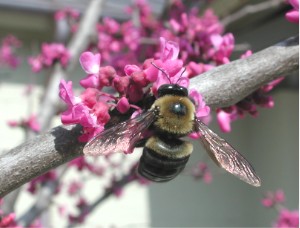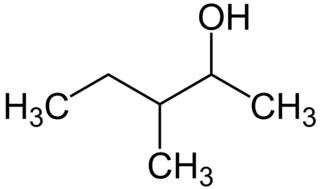
In chemistry, alcohol is an organic compound that carries at least one hydroxyl functional group (−OH) bound to a saturated carbon atom. The term alcohol originally referred to the primary alcohol ethanol (ethyl alcohol), which is used as a drug and is the main alcohol present in alcoholic drinks. An important class of alcohols, of which methanol and ethanol are the simplest members, includes all compounds for which the general formula is CnH2n+1OH. Simple monoalcohols that are the subject of this article include primary (RCH2OH), secondary (R2CHOH) and tertiary (R3COH) alcohols.

Ethanol (also called ethyl alcohol, grain alcohol, drinking alcohol, or simply alcohol) is an organic chemical compound. It is a simple alcohol with the chemical formula C2H6O. Its formula can be also written as CH
3−CH
2−OH or C
2H
5OH (an ethyl group linked to a hydroxyl group), and is often abbreviated as EtOH. Ethanol is a volatile, flammable, colorless liquid with a characteristic wine-like odor and pungent taste. It is a psychoactive drug, recreational drug, and the active ingredient in alcoholic drinks.

Methanol, also known as methyl alcohol, amongst other names, is a chemical and the simplest alcohol, with the formula CH3OH (a methyl group linked to a hydroxyl group, often abbreviated MeOH). It is a light, volatile, colourless, flammable liquid with a distinctive alcoholic odour similar to that of ethanol (potable alcohol). A polar solvent, methanol acquired the name wood alcohol because it was once produced chiefly by the destructive distillation of wood. Today, methanol is mainly produced industrially by hydrogenation of carbon monoxide.

Methyl isocyanate (MIC) is an organic compound with the molecular formula CH3NCO. Synonyms are isocyanatomethane, methyl carbylamine and MIC. Methyl isocyanate is an intermediate chemical in the production of carbamate pesticides (such as carbaryl, carbofuran, methomyl, and aldicarb). It has also been used in the production of rubbers and adhesives. As a highly toxic and irritating material, it is extremely hazardous to human health. It was the principal toxicant involved in the Bhopal disaster, which killed 2,259 people initially and officially 20,000 people in total.
Ethanal (common name acetaldehyde) is an organic chemical compound with the formula CH3CHO, sometimes abbreviated by chemists as MeCHO (Me = methyl). It is one of the most important aldehydes, occurring widely in nature and being produced on a large scale in industry. Acetaldehyde occurs naturally in coffee, bread, and ripe fruit, and is produced by plants. It is also produced by the partial oxidation of ethanol by the liver enzyme alcohol dehydrogenase and is a contributing cause of hangover after alcohol consumption. Pathways of exposure include air, water, land, or groundwater, as well as drink and smoke. Consumption of disulfiram inhibits acetaldehyde dehydrogenase, the enzyme responsible for the metabolism of acetaldehyde, thereby causing it to build up in the body.

Methyl nitrite is an organic compound with the chemical formula CH
3ONO. It is a gas, and is the simplest alkyl nitrite.

Isoamyl alcohol is a colorless liquid with the formula C
5H
12O, specifically (H3C–)2CH–CH2–CH2–OH. It is one of several isomers of amyl alcohol (pentanol). It is also known as isopentyl alcohol, isopentanol, or (in the IUPAC recommended nomenclature) 3-methyl-butan-1-ol. An obsolete name for it was isobutyl carbinol.

Bees can suffer serious effects from toxic chemicals in their environments. These include various synthetic chemicals, particularly insecticides, as well as a variety of naturally occurring chemicals from plants, such as ethanol resulting from the fermentation of organic materials. Bee intoxication can result from exposure to ethanol from fermented nectar, ripe fruits, and manmade and natural chemicals in the environment.

tert-Amyl alcohol (TAA) or 2-methylbutan-2-ol (2M2B), is a branched pentanol.
Isopropyl alcohol (IUPAC name propan-2-ol and also called isopropanol or 2-propanol) is a colorless, flammable chemical compound (chemical formula CH3CHOHCH3) with a strong odor. As an isopropyl group linked to a hydroxyl group, it is the simplest example of a secondary alcohol, where the alcohol carbon atom is attached to two other carbon atoms. It is a structural isomer of 1-propanol and ethyl methyl ether.

2-Methyl-1-butanol is an organic compound with the formula CH3CH2CH(CH3)CH2OH. It is one of several isomers of amyl alcohol. A colorless liquid, it occurs naturally in trace amounts and has attracted some attention as a potential biofuel, exploiting its hydrophobic (gasoline-like) and branched structure. It is chiral.

2-Pentanol is an organic chemical compound. It is used as a solvent and an intermediate in the manufacturing of other chemicals. 2-Pentanol is a component of many mixtures of amyl alcohols sold industrially. 2-Pentanol is chiral and thus can be obtained as either of two stereoisomers designated as (R)-(−)-2-pentanol and (S)-(+)-2-pentanol.

3-Methyl-1-pentanol is an organic chemical compound. It occurs naturally in Capsicum frutescens, the tabasco pepper.

2-Methyl-1-pentanol is an organic chemical compound. It is used as a solvent and an intermediate in the manufacture of other chemicals.

Isohexanol is an organic chemical compound. It is found in longan fruit.

3-Methyl-2-pentanol is an organic chemical compound. It has been identified as a component of hops. Its presence in urine can be used to test for exposure to 3-methylpentane.

4-Methyl-2-pentanol or methyl isobutyl carbinol (MIBC) is an organic chemical compound used primarily as a frother in mineral flotation. It is also used as a solvent, in organic synthesis, and in the manufacture of brake fluid and as a precursor to some plasticizers.

2-Methyl-3-pentanol is an organic chemical compound. It is used as a fuel.

3-Methyl-3-pentanol is an organic chemical compound and a tertiary hexanol. It is used in the synthesis of the tranquilizer emylcamate, and has similar sedative and anticonvulsant actions itself.
3-Methyl-2-butanol is an organic chemical compound. It is used as a solvent and an intermediate in the manufacture of other chemicals.



















